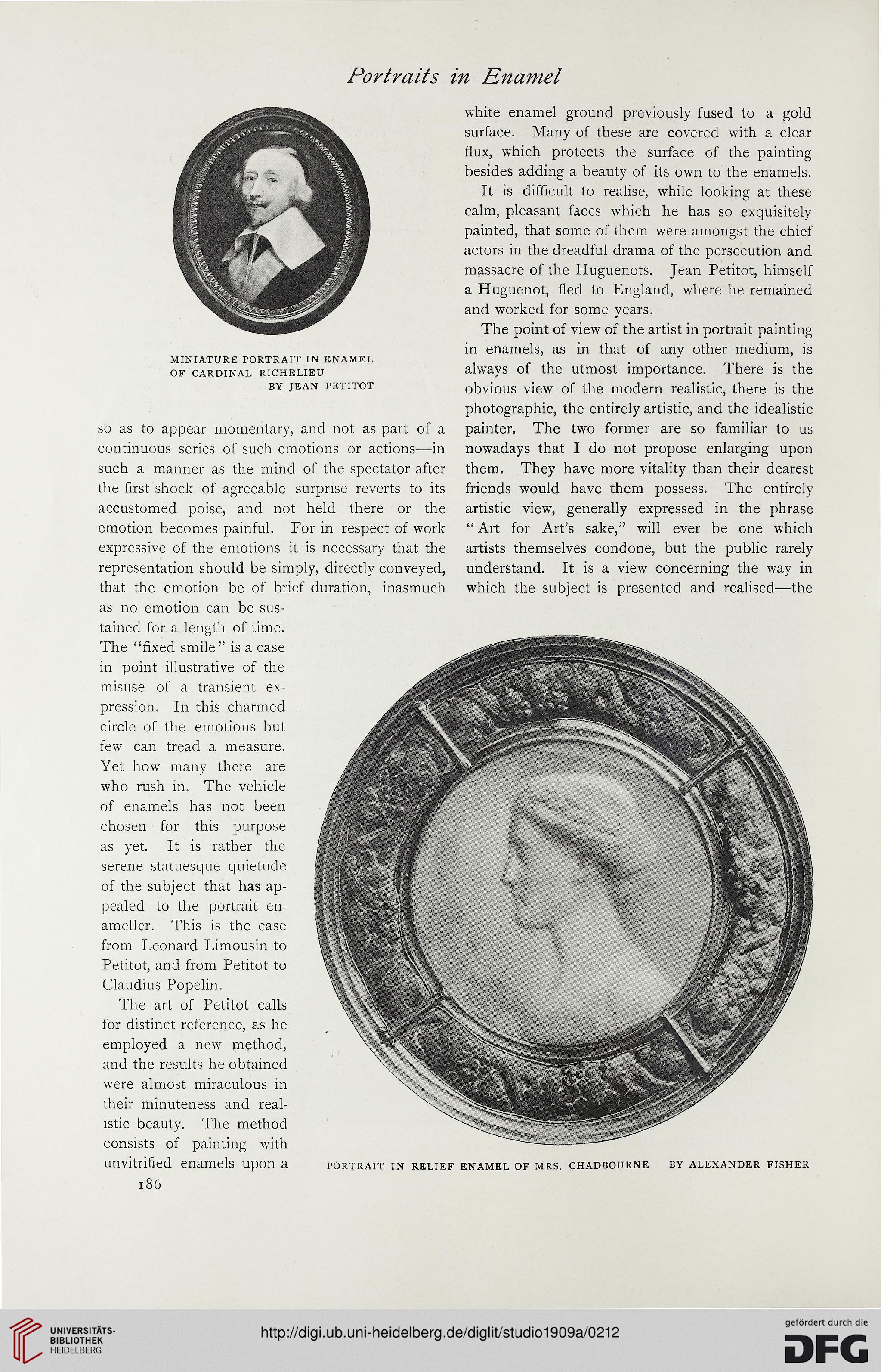Portraits in Enajnel
MINIATURE TORTRAIT IN ENAMEL
OF CARDINAL RICHELIEU
BY JEAN PETITOT
so as to appear momentary, and not as part of a
continuous series of such emotions or actions—in
such a manner as the mind of the spectator after
the first shock of agreeable surprise reverts to its
accustomed poise, and not held there or the
emotion becomes painful. For in respect of work
expressive of the emotions it is necessary that the
representation should be simply, directly conveyed,
that the emotion be of brief duration, inasmuch
as no emotion can be sus-
tained for a length of time.
The “fixed smile ” is a case
in point illustrative of the
misuse of a transient ex-
pression. In this charmed
circle of the emotions but
few can tread a measure.
Yet how many there are
who rush in. The vehicle
of enamels has not been
chosen for this purpose
as yet. It is rather the
serene statuesque quietude
of the subject that has ap-
pealed to the portrait en-
ameller. This is the case
from Leonard Limousin to
Petitot, and from Petitot to
Claudius Popelin.
The art of Petitot calls
for distinct reference, as he
employed a new method,
and the results he obtained
were almost miraculous in
their minuteness and real-
istic beauty. The method
consists of painting with
unvitrified enamels upon a
186
white enamel ground previously fused to a gold
surface. Many of these are covered with a clear
flux, which protects the surface of the painting
besides adding a beauty of its own to the enamels.
It is difficult to realise, while looking at these
calm, pleasant faces which he has so exquisitely
painted, that some of them were amongst the chief
actors in the dreadful drama of the persecution and
massacre of the Huguenots. Jean Petitot, himself
a Huguenot, fled to England, where he remained
and worked for some years.
The point of view of the artist in portrait painting
in enamels, as in that of any other medium, is
always of the utmost importance. There is the
obvious view of the modern realistic, there is the
photographic, the entirely artistic, and the idealistic
painter. The two former are so familiar to us
nowadays that I do not propose enlarging upon
them. They have more vitality than their dearest
friends would have them possess. The entirely
artistic view, generally expressed in the phrase
“Art for Art’s sake,” will ever be one which
artists themselves condone, but the public rarely
understand. It is a view concerning the way in
which the subject is presented and realised—the
BY ALEXANDER FISHER
PORTRAIT IN RELIEF ENAMEL OF MRS. CHADBOURNE
MINIATURE TORTRAIT IN ENAMEL
OF CARDINAL RICHELIEU
BY JEAN PETITOT
so as to appear momentary, and not as part of a
continuous series of such emotions or actions—in
such a manner as the mind of the spectator after
the first shock of agreeable surprise reverts to its
accustomed poise, and not held there or the
emotion becomes painful. For in respect of work
expressive of the emotions it is necessary that the
representation should be simply, directly conveyed,
that the emotion be of brief duration, inasmuch
as no emotion can be sus-
tained for a length of time.
The “fixed smile ” is a case
in point illustrative of the
misuse of a transient ex-
pression. In this charmed
circle of the emotions but
few can tread a measure.
Yet how many there are
who rush in. The vehicle
of enamels has not been
chosen for this purpose
as yet. It is rather the
serene statuesque quietude
of the subject that has ap-
pealed to the portrait en-
ameller. This is the case
from Leonard Limousin to
Petitot, and from Petitot to
Claudius Popelin.
The art of Petitot calls
for distinct reference, as he
employed a new method,
and the results he obtained
were almost miraculous in
their minuteness and real-
istic beauty. The method
consists of painting with
unvitrified enamels upon a
186
white enamel ground previously fused to a gold
surface. Many of these are covered with a clear
flux, which protects the surface of the painting
besides adding a beauty of its own to the enamels.
It is difficult to realise, while looking at these
calm, pleasant faces which he has so exquisitely
painted, that some of them were amongst the chief
actors in the dreadful drama of the persecution and
massacre of the Huguenots. Jean Petitot, himself
a Huguenot, fled to England, where he remained
and worked for some years.
The point of view of the artist in portrait painting
in enamels, as in that of any other medium, is
always of the utmost importance. There is the
obvious view of the modern realistic, there is the
photographic, the entirely artistic, and the idealistic
painter. The two former are so familiar to us
nowadays that I do not propose enlarging upon
them. They have more vitality than their dearest
friends would have them possess. The entirely
artistic view, generally expressed in the phrase
“Art for Art’s sake,” will ever be one which
artists themselves condone, but the public rarely
understand. It is a view concerning the way in
which the subject is presented and realised—the
BY ALEXANDER FISHER
PORTRAIT IN RELIEF ENAMEL OF MRS. CHADBOURNE




